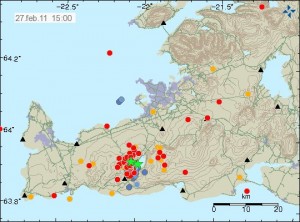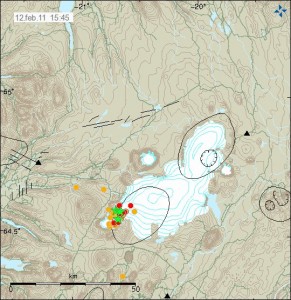After four days of continues earthquake activity it appears that Krísuvík volcano has stepped up it’s activity by a order of magnitude. Since midnight there have been over 400 earthquakes in Krísuvík volcano. The activity is continuing when this is written and does not show any signs of slowing down at this moment. Geologist in Iceland are expecting more earthquakes in this area over the next hours and even earthquakes that are larger then ML3.0 in size.
The largest earthquakes where ML3.3 and ML3.7 in size. This is automatic size by the SIL system. The depth of the earthquakes was 4.7 km and 1.1 km according to the automatic SIL system. Due to high number of earthquakes the SIL system is putting earthquakes down all around the Reykjanes Peninsula. While there might be some earthquakes there, the number is not nearly as high as can be seen on the map. The earthquakes can be located by there low quality number.
Given the location and how this earthquake swarm is behaving it is my opinion that this is due to a magma is pushing up the crust in this area. But it remains a question of this is going to start a eruption or not. But the chances are growing for as long as this earthquake pattern holds up in Krísuvík volcano. If a eruption starts in Krísuvík volcano it is going to one of Hawaii type eruption, unless it is under water then it is going to be explosive for as long there is water getting into the crater. Last time there was a eruption in this area a 25 km long eruption fissure did form.
For now however all that can be done is to wait and see what happens. This earthquake swarm is going to continue for the next few hours and even days. The largest earthquakes can be seen on my geophone sensors here.


Map of the earthquake swarm in Krísuvík at 15:00 UTC. Picture is from Icelandic Met Office web page. Copyright belongs to them.
Icelandic news about this earthquake. Use Google translate at own risk.
Búist við áframhaldandi virkni (Rúv.is)
Engin merki um gosóróa (Rúv.is)
Heldur rólegra síðasta hálftímann (Vísir.is)
Jarðskjálftinn var 4 stig að stærð – 200 skjálftar frá miðnætti (Vísir.is)
Jarðskjálfti í Reykjavík (Vísir.is, 09:13 UTC)
Hætta á fleiri skjálftum (mbl.is)
Skjálftinn var nær höfuðborgarsvæðinu (mbl.is, 11:00 UTC)
Jarðskjálfti í Reykjavík (mbl.is, 09:07 UTC)
Skjálftinn líklega 4 stig (mbl.is)
Kort af skjálftanum (mbl.is)
Dregið hefur úr skjálftahrinunni (Vísir.is)
Tveir snarpir jarðskjálftar 24 km SSV af Reykjavík (DV.is)
Note: Check time stamps of the news articles.
Blog post updated at 14:50 CET on the 27.02.2011.
Blog post updated at 16:14 CET on the 27.02.2011.




